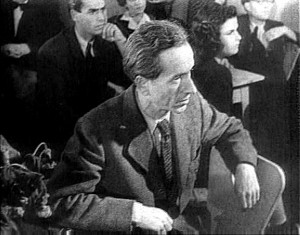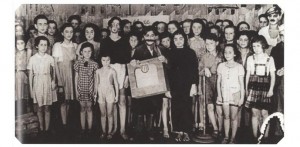I am proud to announce that my website has just been awarded the Polish Music Critics 'Kropka’ Award – given for the text published almost a year ago, just after the anniversary of the Warsaw ghetto uprising. Today marks the 73. anniversary of this event, one of the most remarkable acts of resistance in World War II. Hereby I repost my essay in English, to perpetuate the memory of all children perished in the Holocaust.
***
In November 1941, Heinrich Himmler issued a command to close the Austrian fortress in Terezín – which two years previously had found itself within the Protectorate of Bohemia and Moravia, occupied by the Third Reich – and transform it into a Jewish ghetto, with the transition camp already active since 1940 integrated into the defensive wall system. Nazi propaganda presented Theresienstadt as a model ghetto, the pattern for a modern Jewish settlement – indeed, a ‘family camp’ (Familienlager). Rumors spreading to the effect that the city was serving as a gigantic concentration camp were denied in every possible way. When a transport of about 500 Jews from Denmark arrived in Terezín and activists from the Danish Red Cross categorically demanded an inspection, the Germans agreed to it and proceeded to quickly ‘clean up’ the ghetto. They painted some of the rooms, sealed others off from the guests, arranged a few extra transports to Auschwitz in order to – at least for the moment – limit overpopulation; after that, they took up closer supervision of the inhabitants’ cultural activity. There was no need to encourage anyone to take part in the latter – at that time, the ghetto’s residents included the elite of Jewish political, cultural and academic life.
The Danes left Terezín completely satisfied, having discerned no improprieties in the camp’s management. The Germans continued the momentum: they instructed one of the prisoners, Kurt Gerron, who ran the Karussell cabaret there, to make a propaganda film about the life of the local Jewish community. They assured Gerron that not a hair would fall from his head. The filming lasted eleven days and ended in mid-September 1944. The promise was not kept: both the director and most of the endeavor’s participants captured on film were taken away to Auschwitz and gassed. The first showing of the edited material, intended for high-ranking state officials and SS members, took place in April of the next year. In succeeding weeks, the film reached the hands of representatives of several international humanitarian organizations. On 3 May, the camp found itself under the control of the Red Cross; five days later, the Red Army entered the fortress. The propaganda ‘document’ was almost completely destroyed. About 20 minutes of the film survived – among others, shots from a performance of Pavel Haas’ Studie for string instruments under the baton of Karel Ančerl; fragments from a performance of the Ghetto Swingers jazz band; and the final scenes from Hans Krása’s children’s opera Brundibár.
Krása was the son of a Czech lawyer and a German Jewish woman. A violinist, pianist and composer educated in Prague and Berlin (a student of, among others, Zemlinsky and Roussell), he composed this little 40-minute work in 1938, in collaboration with librettist Adolf Hoffmeister, for a competition of the Czechoslovak Ministry of Education. The results were never announced: the German army entered Prague a few months before the competition’s expected adjudication. In 1941, Krása placed the notated materials in the hands of the Jewish war orphans’ home on Belgická street in the Vinohrady district of Prague, where in the winter of 1942, the première of Brundibár took place under the baton of Rudolph Freudenfeld, with simple scenery and costumes designed by František Zelenka, and with Gideon Klein at the piano, along with a violinist and percussionist whose names I have not managed to find. The composer did not take part in this event: arrested on 10 August 1942, he ended up in Theresienstadt, where he became the ‘music man’ as part of the camp’s Freizeitgestaltung, the organization of his co-prisoners’ free time. Soon thereafter, nearly all of the creators and performers of the Prague show joined him there. Freudenfeld managed to smuggle in a piano reduction in his baggage, on the basis of which Krása re-orchestrated the opera, adapting it to the resources of the local instrumental ensemble.
Hans Krása listens to a concert conducted by Ančerl; Theresienstadt, 1943.
The story of Aninka and Pepíček – a pair of siblings orphaned by their father who have to get fresh milk for their sick mother, but have no money, so they follow in the footsteps of the street organ-grinder Brundibár (a big, fat Bumblebee) and try to earn money for their purchases by singing – is basically a quite simple and in principle universal tale of the victory of good over evil. Inspired by Hansel and Gretel and The Town Musicians of Bremen of the Brothers Grimm, compared in a somewhat exaggerated manner by later interpreters with Aristophanes’ pacifist Lysistrata, it took on entirely new meanings in Theresienstadt and grew to the stature of a symbol of the vicissitudes of Jewish life. The mustachioed organ-grinder, who at first chases away the competitors, then tries to rob them, became a figure of the hated Hitler. The brave sparrow, the clever cat, the wise dog and the band of city children – these served as a metaphor for a close-knit community that effectively faces violence and restores the old world order. The realizers introduced characteristic corrections into the libretto: the condition for joining the group of intrepid defenders of good became courage and love of justice – in the place of the original love of homeland and obedience to parents. Brundibár was played in Terezín fifty-five times. Real fights broke out over tickets to the shows. The child performers of the lead roles enjoyed great respect among their peers.
The young viewers sought to forget themselves in the theater, grabbed the simple, tuneful melodies from out in the audience, fed themselves with the delusive hope that in this resounding allegory, there lay at least some small grain of truth. Meanwhile, new faces were continually appearing in the 40-person choir, because previous performers had fallen victim to illness, chronic malnutrition, departed from Theresienstadt to Auschwitz and to Trostinets (near Minsk) in transports from which there was no return. They cheered their heroes: the peerless Honza Treichlinger in the title role, Pinta Mühlstein and Greta Hofmeister in the roles of Pepíček and Aninka. However ghastly this may sound, they waited their turn, knowing that at any moment, they might join the ranks of the decimated choir or join the elite group of soloists in Brundibár.
After a showing of Brundibár. In the middle, Honza Treichlinger, creator of the title role; at his left hand, Ela Stein-Weissberger (the Cat)
Some managed to escape from this hell. Ela Stein-Weissberger, performer of the role of the Cat in all (or nearly all, as some witnesses claim) of the shows in Terezín, lived to see the camp liberated; she emigrated to Israel, then to New York, where she lives to this day and actively takes part in post-war attempts to revive Brundibár and sustain the memory of her fellow child performers in the opera. Little Rafi Herz-Sommer, creator of the role of the Sparrow, was barely eight years old at the moment when the Theresienstadt camp was liberated. His father, ’cellist Leopold Sommer, had died a year previously at Dachau. In 1945, the orphaned boy returned to Prague with his mother, pianist Alice Herz-Sommer, with whom he emigrated to Jerusalem four years later. He finally settled in England and gained renown as Raphaël Sommer, a ’cello virtuoso, distinguished pedagogue and organizer of musical life. He died in 2001 – his mother survived him by thirteen years and died a few months after her 110th birthday, as the oldest Holocaust survivor in the world.
Honza Treichlinger was not so lucky. He died at Auschwitz along with most of the children’s choir members, the show’s stage director Emil Saudek and the aforementioned Kurt Gerron. Hans Krása left Theresienstadt in the same transport as three other composer friends: Viktor Ullmann, Pavel Haas and Gideon Klein, the latter of whom had accompanied the performers of the world première in the Vinohrady district of Prague. All except for Klein were gassed in the second half of October 1944. Klein died in January of the next year, not having lived to see the end of the war.
Someone will say that the memory of them all lives on in the score of Brundibár. Their death was, however, terrible, futile and senseless. The only comfort is the hope that participation in the Terezín shows anesthetized them to that death, alleviated the premonition of their end. Velimir Khlebnikov wrote about suns that die by fading away; grass that dies by drying out; horses that die by quietly drawing their last breath; and people that die by singing songs. The children at Theresienstadt died singing a song about friendship that overthrows tyrants.
Translated by: Karol Thornton-Remiszewski.


